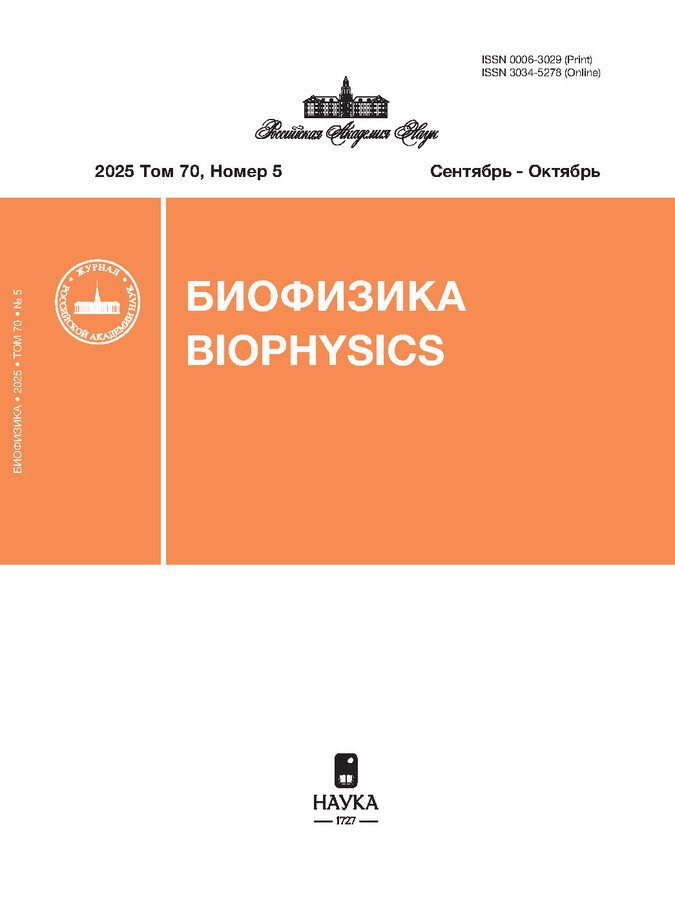ЭФФЕКТЫ САЛИЦИЛОВОЙ И АЦЕТИЛСАЛИЦИЛОВОЙ КИСЛОТ В МИТОХОНДРИАЛЬНЫХ И ЭРИТРОЦИТАРНЫХ МЕМБРАНАХ
- Авторы: Ильич Т.В1, Савко А.И1, Коваленя Т.А1, Лапшина Е.А1, Заводник И.Б1
-
Учреждения:
- Гродненский государственный университет имени Янки Купалы
- Выпуск: Том 69, № 5 (2024)
- Страницы: 997-1010
- Раздел: Биофизика клетки
- URL: https://rjonco.com/0006-3029/article/view/676131
- DOI: https://doi.org/10.31857/S0006302924050073
- EDN: https://elibrary.ru/MKGOYO
- ID: 676131
Цитировать
Полный текст
Аннотация
Об авторах
Т. В Ильич
Гродненский государственный университет имени Янки Купалы
Email: ilich_tv@grsu.by
Гродно, 230009, Беларусь
А. И Савко
Гродненский государственный университет имени Янки КупалыГродно, 230009, Беларусь
Т. А Коваленя
Гродненский государственный университет имени Янки КупалыГродно, 230009, Беларусь
Е. А Лапшина
Гродненский государственный университет имени Янки КупалыГродно, 230009, Беларусь
И. Б Заводник
Гродненский государственный университет имени Янки КупалыГродно, 230009, Беларусь
Список литературы
- Hawley S. A., Fullerton M. D., Ross F. A., Schertzer J. D., Chevtzoff C., Walker K. J., Peggie M. W., Zibrova D., Green K. A., Mustard K. J., Kemp B. E., Sakamoto K., Steinberg G. R., and Hardie D. G. The ancient drug salicylate directly activates AMP-activated protein kinase. Science, 336 (6083), 918–922 (2012). doi: 10.1126/science.1215327
- Tewari D., Majumdar D., Vallabhaneni S., and Bera A. K. Aspirin induces cell death by directly modulating mitochondrial voltage-dependent anion channel (VDAC). Sci. Rep., 22 (7), 45184 (2017). doi: 10.1038/srep45184
- Smith B. K., Ford R. J., Desjardins E. M., Green A. E., Hughes M. C., Houde V. P., Day E. A., Marcinko K., Crane J. D., Mottillo E. P., Perry C. G. R., Kemp B. E., Tarnopolsky M. A., and Steinberg G. R. Salsalate (Salicylate) uncouples mitochondria, improves glucose homeostasis, and reduces liver lipids independent of AMPK-β1. Diabetes, 65 (11), 3352–3361 (2016). doi: 10.2337/db16-0564
- Lapshina E. A., Sudnikovich E. J., Maksimchik J. Z., Zabrodskaya S. V., Zavodnik L. B., Kubyshin V. L., Nocun M., Kazmierczak P., Dobaczewski M., Watala C., and Zavodnik I. B. Antioxidative enzyme and glutathione S-transferase activities in diabetic rats exposed to long-term ASA treatment. Life Sci., 79 (19), 1804–1811 (2006). doi: 10.1016/j.lfs.2006.06.008
- Suwalsky M., Belmar J., Villena F., Gallardo M. J., Jemiola-Rzeminska M., and Strzalka K. Acetylsalicylic acid (aspirin) and salicylic acid interaction with the human erythrocyte membrane bilayer induce in vitro changes in the morphology of erythrocytes. Arch. Biochem. Biophys., 539 (1), 9–19 (2013). doi: 10.1016/j.abb.2013.09.006
- Norman C., Howell K. A., Millar A. H., Whelan J. M., and Day D. A. Salicylic acid is an uncoupler and inhibitor of mitochondrial electron transport. Plant Physiol., 134 (1) 492–501 (2004). doi: 10.1007/s10725-009-9416-6
- Poór P. Effects of salicylic acid on the metabolism of mitochondrial reactive oxygen species in plants. Biomolecules, 10 (2), 341 (2020). doi: 10.3390/biom10020341
- Ordan O., Rotem R., Jaspers I., and Flescher E. Stressresponsive JNK mitogen-activated protein kinase mediates aspirin-induced suppression of B16 melanoma cellular proliferation. Br. J. Pharmacol., 138 (6), 1156–1162 (2003). doi: 10.1038/sj.bjp.0705163
- Penniall R. The effects of salicylic acid on the respiratory activity of mitochondria. Biochim. Biophys. Acta, 30 (2), 247–251 (1958). doi: 10.1016/0006-3002(58)90047-7
- Brody T. M. Action of sodium salicylates and related compounds on tissue metabolism in vitro. J. Pharmacol. Exp. Ther., 117, 39–51 (1956).
- Zhao L., Zhang W., Chen M., Zhang J., Zhang M., and Dai K. Aspirin induces platelet apoptosis. Platelets, 24 (8), 637–642 (2013). doi: 10.3109/09537104.2012.754417
- Yoshida Y., Singh I., and Darby C. P. Effects of salicylic acid and calcium on mitochondrial functions. Acta. Neurol. Scand., 85 (3), 191–196 (1992). doi: 10.1111/j.1600-0404.1992.tb04026.x
- Battaglia V., Salvi M., and Toninello A. Oxidative stress is responsible for mitochondrial permeability transition induction by salicylate in liver mitochondria. J. Biol. Chem., 280 (40), 33864–33872 (2005). doi: 10.1074/jbc.M502391200
- Folmes C. D. L., Dzeja P. P., Nelson T. J., and Terzic A. Mitochondria in control of cell fate. Circ. Res., 110 (4), 526–529 (2012). doi: 10.1161/RES.0b013e31824ae5c1
- Zavodnik I. B. Mitochondria, calcium homeostasis and calcium signaling. Biomeditsinskaya khimiya, 62 (3), 311–317 (2016). doi: 10.18097/PBMC20166203311
- Contreras L., Drago I., Zampese E., and Pozzan T. Mitochondria: the calcium connection. Biochim. Biophys. Acta, 1797, 607–618 (2010). doi: 10.1016/j.bbabio.2010.05.005
- Rasola A. and Bernardi P. Mitochondrial permeability transition in Ca2+-dependent apoptosis and necrosis. Cell Calcium, 50 (3), 222–233 (2011). doi: 10.1016/j.ceca.2011.04.007
- Rossi A., Pizzo P., and Filadi R., Calcium, mitochondria and cell metabolism: a functional triangle in bioenergetics. Biochim. Biophys. Acta, 1866 (7), 1068–1078 (2019). doi: 10.1016/j.bbamcr.2018.10.016
- Fujikawa I., Ando T., Suzuki-Karasaki M., SuzukiKarasaki M., Ochiai T., and Suzuki-Karasaki Y. Aspirin induces mitochondrial Ca2+ remodeling in tumor cells via ROS‒depolarization‒voltage-gated Ca2+ entry. Int. J. Mol. Sci., 21 (13), 4771 (2020). doi: 10.3390/ijms21134771
- Trost L. C. and Lemasters J. J. Role of the mitochondrial permeability transition in salicylate toxicity to cultured rat hepatocytes: implications for the pathogenesis of Reye's syndrome. Toxicol. Appl. Pharmacol., 147, 431–441 (1997). doi: 10.1006/taap.1997.8313
- Doi H. and Horie T. Salicylic acid-induced hepatotoxicity triggered by oxidative stress. Chem. Biol. Interact., 183 (3), 363–368 (2010). doi: 10.1016/j.cbi.2009.11.024
- Tomoda T., Takeda K., Kurashige T., Enzan H., and Miyahara M. Acetylsalicylate (ASA)-induced mitochondrial dysfunction and its potentiation by Ca2+. Liver, 14 (2), 103–108 (1994). doi: 10.1111/j.1600-0676.1994.tb00056.x
- Schummer U., Schiefer H.-G., and Gerhardt U. Mycoplasma membrane potentials determined by potential-sensitive fluorescent dyes. Curr. Microbiol., 2, 191– 194 (1979).
- Augustyniak K., Zavodnik I., Palecz D., Szosland K., and Bryszewska M. The effect of oxidizing agents and diabetes mellitus on the human red blood cell membrane potential. Clin. Biochem., 29 (3), 283–286 (1996). doi: 10.1016/0009-9120(95)02045-n
- Johnson D. and Lardy H. A. Isolation of rat liver and kidney mitochondria. Methods Enzymol., 10, 94–101 (1967). doi: 10.1016/0076-6879(67)10018-9
- Lowry O. H., Rosebrough N. J., Farr A. L., and Randall R. J. Protein measurement with the Folin phenol reagent. J. Biol. Chem., 193 (1), 265–275 (1951).
- Akerman K. E. Qualitative measurements of the mitochondrial membrane potential in situ in Ehrlich ascites tumour cells using the safranine method. Biochim. Biophys. Acta., 546 (2), 341–347 (1979). doi: 10.1016/0005-2728(79)90051-3
- Moore A. L. and Bonner W. D. Measurements of membrane potentials in plant mitochondria with the safranine method. Plant Physiol., 70, 1271–1276 (1982). doi: 10.1104/pp.70.5.1271
- Petronilli V., Cola C., Massari S., Colonna R., and Bernardi P. Physiological effectors modify voltage sensing by the cyclosporin A-sensitive permeability transition pore of mitochondria. J. Biol. Chem., 268, 21939–21945 (1993).
- Dremza I. K., Lapshina E. A., Kujawa J., and Zavodnik I. B. Oxygen-related processes in red blood cells exposed to tert-butyl hydroperoxide. Redox Report, 11 (4), 185–192 (2006). doi: 10.1179/135100006X116709
- Poór P., Patyi G., Takács Z., and Szekeres A. Salicylic acid-induced ROS production by mitochondrial electron transport chain depends on the activity of mitochondrial hexokinases in tomato (Solanum lycopersicum L.). J. Plant Res., 132 (2), 273–283 (2019). doi: 10.1007/s10265-019-01085-y
- Xie Z. and Chen Z. Salicylic acid induces rapid inhibition of mitochondrial electron transport and oxidative phosphorylation in tobacco cells. Plant Physiol., 120 (1), 217–226 (1999).
- Zavodnik I. B., Dremza I. K., Cheshchevik V. T., and Lapshina E. A. Oxidative damage of rat liver mitochondria during exposure to t-butyl hydroperoxide. Role of Ca2+ ions in oxidative processes. Life Sci., 92, 1110– 1117 (2013).
- Neginskaya M. A., Morris S. E., and Pavlov E. V. Both ANT and ATPase are essential for mitochondrial permeability transition but not depolarization. Science, 25, 105447 (2022). doi: 10.1016/j.isci.2022.105447
- Golovach N. G., Cheshchevik V. T., Lapshina E. A., Ilyich T. V., and Zavodnik I. B. Calcium-induced mitochondrial permeability transitions: parameters of Ca2+ ion interactions with mitochondria and effects of oxidative agents. Membrane Biol., 250 (2), 225–236 (2017). doi: 10.1007/s00232-017-9953-2
- Petrescu I. and Tarba C. Uncoupling effects of diclofenac and aspirin in the perfused liver and isolated hepatic mitochondria of rat. Biochim. Biophys. Acta., 1318 (3), 385–394 (1997). doi: 10.1016/s0005-2728(96)00109-0
- Martens M. E. and Lee C. P. Reye's syndrome: salicylates and mitochondrial functions. Biochem. Pharmacol., 33 (18), 2869–2876 (1984). doi: 10.1016/0006-2952(84)90209-0
- Nulton-Persson A. C., Szweda L. I., and Sadek H. A. Inhibition of cardiac mitochondrial respiration by salicylic acid and acetylsalicylate. J. Cardiovasc. Pharmacol., 44 (5), 591–595 (2004). doi: 10.1097/00005344-200411000-00012
- Jonas E. A., Jr Porter C. A., Beutner G., Mnatsakanyan N., and Alavian K. N. Cell death disguised: the mitochondrial permeability transition pore as the c-subunit of the F1FO ATP synthase. Pharmacol. Res., 99, 382–392 (2015).
- Li A., Seipelt H., Müller C., Shi Y., and Artmann M. Effects of salicylic acid derivatives on red blood cell membranes. Pharmacol. Toxicol., 85 (5), 206–211 (1999). doi: 10.1111/j.1600-0773.1999.tb02010.x
- Zavodnik I. B. and Piletskaia T. P. Acid-induced hemolysis of human erythrocytes. Biofizika, 42 (5), 1106– 1112 (1997).
- Ivanov I. T. The low pH-induced hemolysis of erythrocytes is preceded by entry of acid into cytosole and oxidative stress on cellular membranes. Biochim. Biophys. Acta., 1415, 349–360 (1999).
- Gutknecht J. Salicylates and proton transport through lipid bilayer membranes: a model for salicylate-induced uncoupling and swelling in mitochondria. J. Membr. Biol., 115 (3), 253–260 (1990). doi: 10.1007/BF01868640
- G utknecht J. Aspirin, acetaminophen and proton transport through phospholipid bilayers and mitochondrial membranes. Mol. Cell Biochem., 114 (1–2), 3–8 (1992). doi: 10.1007/BF00240290
- Dunn G. E. and Penner T. S. Effect of intramolecular hydrogen bonding on the relative acidities of substituted salicylic acids in benzene solution. Can. J. Chem., 45, 1699–1706 (1967). doi: 10.1139/v67-274
- Zavodnik I. B., Lapshina E. A., Sudnikovich E., Boncler M., Luzak B., Rózalski M., Heliñska M., and Watala C. Structure, stability, and antiplatelet activity of O-acyl derivatives of salicylic acid and lipophilic esters of acetylsalicylate. Pharm. Reports., 61, 476–489 (2009).
- Alsop R. J., Toppozini L., Marquardt D., Kučerka N., Harroun T. A., and Rheinstädter M. C. Aspirin inhibits formation of cholesterol rafts in fluid lipid membranes. Biochim. Biophys. Acta (BBA) – Biomembranes, 1848 (3), 805–812 (2015).
- Alsop R. J., Himbert S., Dhaliwal A., Schmalzl K., and Rheinstädter M. C. Aspirin locally disrupts the liquidordered phase. R. Soc. Open Sci., 5 (2), 171710 (2018). doi: 10.1098/rsos.171710
Дополнительные файлы











